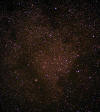
If you're looking for moon pictures see some down below, and/or click here:

Nikon D100 4 images exposed from 2 to 3 minutes, Nikon D100, ISO1250 setting, Tak TOA 130 with reducer (f5.8, 754mm), guided using STV eFinder.
Lots of folks are interested in the Nikon D100's Astrophotography capabilities, and well as the newer D70 cameras. The D100 does OK! This page features a number of links to my D100 Astrophotography. HOWEVER: I'm now shooting with a Canon EOS 20Da.
Blue light, converted to monochrome. Click to see the full-size image. By the way, the moon is 76%, or about 3/4 full. |  M109 plus many dim fuzzies |  Different version of M33 DSLR 9/4/2005 |
| Nikon D100 M31, M11, Double Cluster Images | Stacked D100 M31 | Fixed Tripod Images |
| Super Thin Moon Images | NHAC Pix - Comet Machholz & The Pleiades (The Seven Sisters) | |
 North American Nebula Above: Single exposure 129 seconds, Nikon 180mm f2.8 ED lens @ f2.8, ISO 800 setting. See a better image using film North American Nebula - Film | Below: film images of the moonset from the same evening. Nice! | |
 M7 As left, but ISO setting 800 saving as a raw file. This is the full frame with the usual processing in photoshop. I think I see a bit of structure in surrounding Milky Way area. |   North of Sagittarius Above: a couple of 30 sec exposures, Nikon 55mm f2.8 Macro lens @ f2.8, ISO 1000 setting. | |
| Featured Astronomy Photos | Lunar Images | NHAC Mars Party Shots |
| Ernie's D100 astro images | My NHAC Page | Jerry L's Nikon Canon Astrophotography Page |
| Nikon D100 daylight Images | Why Film Astrophotography? |
I used a Nikon D100 DSLR camera to capture the images on this page. Images generally: Tak FS-102 prime focus with reducer at 610mm focal length, f5.9 SBIG STV autoguider using Celestron ST-80 guidescope, Losmandy GM-11 mount.
Copyright © 2003-2006 Dick Locke. All Rights Reserved.
Contact and Image Use Information
Regarding D100 noise for long astronomy photos:
Two to three minutes at ISO 1000 is a good starting place. A 6 minute exposure at 800 in raw mode did not turn out well at all. A 6 minute at ISO 1250 had too much noise even when using noise reduction. I also did 30 second exposures on some deep sky objects that might be worth stacking, but there's not a lot of signal.
Using the higher ISO setting and keeping the exposures shorter seems
to be best with this camera.
2005 update: the ambient temperature is critical to exposure time. You can get away with some long exposures in 40 degree (F) weather. You can't go for more than two minutes at ISO 800 in 80 degree weather.
2005 update 2: Canon D20a and Nikon D100 noise comparison here.
-Dick